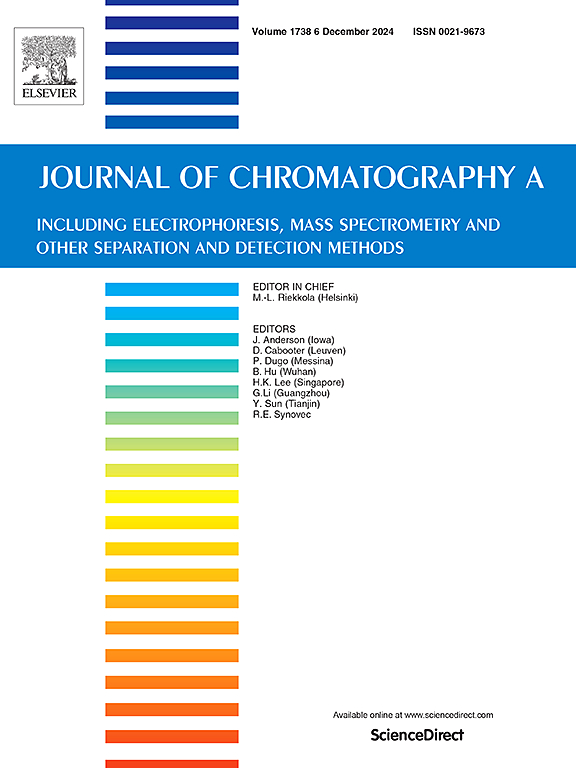Evaluating the potential of hydrophilic interaction liquid chromatography for collagen peptide mapping analysis
IF 3.8
2区 化学
Q1 BIOCHEMICAL RESEARCH METHODS
引用次数: 0
Abstract
This study presents a systematic approach for developing an innovative hydrophilic interaction liquid chromatography (HILIC) method for collagen peptide mapping analysis. The predominant post-translational modification (PTM) of collagen, proline hydroxylation, introduces polar hydroxyl groups throughout the collagen sequence, making HILIC a promising alternative to classical reversed-phase liquid chromatography (RPLC) approaches. This study employs sixteen model peptides, selected from in silico predicted tryptic peptides with zero missed cleavages and representing diverse physicochemical properties and structural motifs of collagen. The peptides were used as standards to conduct detailed chromatographic evaluation. Various HILIC stationary phases and mobile phases were systematically examined to identify optimal separation conditions for collagen peptides, contributing to a better understanding of peptide behavior in HILIC. The study also explores the effects of sample diluent and injection mode, comparing classical injection with the Performance Optimizing Injection Sequence (POISe), to determine their impact on HILIC performance. Introducing a plug of weak solvent (acetonitrile) prior to sample injection, effectively mitigates the mismatch in eluent strength between the fully aqueous sample diluent (resulting from tryptic digestion) and the mobile phase, addressing issues of peak distortion. Different injection volumes (from 0.5 to 8 µL) and acetonitrile ratios (1:1, 1:2, 1:5 and 1:10) were tested to optimize sample injection and increase sensitivity of collagen tryptic peptides.
Following method optimization, HILIC was coupled with mass spectrometry (MS) to evaluate its effectiveness in analyzing collagen-digested samples. This evaluation included the assessment of peptide sequence coverage and the method ability to identify hydroxylation patterns, thereby demonstrating its potential for detailed peptide analysis.
评估亲水相互作用液相色谱法在胶原蛋白肽图谱分析中的潜力
本研究提出了一种系统方法,用于开发一种创新的亲水相互作用液相色谱(HILIC)方法,用于胶原蛋白肽图谱分析。胶原蛋白最主要的翻译后修饰(PTM)--脯氨酸羟基化在整个胶原蛋白序列中引入了极性羟基,这使得亲水相互作用液相色谱(HILIC)成为传统反相液相色谱(RPLC)方法的一种很有前景的替代方法。本研究采用了十六种模型肽,这些肽都是根据硅学预测的胰蛋白酶肽筛选出来的,具有零漏裂,代表了胶原蛋白的不同理化性质和结构模式。以这些肽为标准进行了详细的色谱评估。对各种 HILIC 固定相和流动相进行了系统检测,以确定胶原蛋白肽的最佳分离条件,从而更好地了解肽在 HILIC 中的行为。研究还探讨了样品稀释剂和进样模式的影响,比较了传统进样和性能优化进样序列(POISe),以确定它们对 HILIC 性能的影响。在样品进样前加入弱溶剂(乙腈),可有效缓解全水性样品稀释液(由胰蛋白酶消化产生)与流动相之间的洗脱强度不匹配问题,从而解决峰形失真问题。测试了不同的进样量(从 0.5 到 8 µL)和乙腈比例(1:1、1:2、1:5 和 1:10),以优化样品进样并提高胶原蛋白胰蛋白酶肽的灵敏度。该评估包括肽序列覆盖率的评估以及该方法识别羟基化模式的能力,从而证明了其在详细肽分析方面的潜力。
本文章由计算机程序翻译,如有差异,请以英文原文为准。
求助全文
约1分钟内获得全文
求助全文
来源期刊

Journal of Chromatography A
化学-分析化学
CiteScore
7.90
自引率
14.60%
发文量
742
审稿时长
45 days
期刊介绍:
The Journal of Chromatography A provides a forum for the publication of original research and critical reviews on all aspects of fundamental and applied separation science. The scope of the journal includes chromatography and related techniques, electromigration techniques (e.g. electrophoresis, electrochromatography), hyphenated and other multi-dimensional techniques, sample preparation, and detection methods such as mass spectrometry. Contributions consist mainly of research papers dealing with the theory of separation methods, instrumental developments and analytical and preparative applications of general interest.
 求助内容:
求助内容: 应助结果提醒方式:
应助结果提醒方式:


